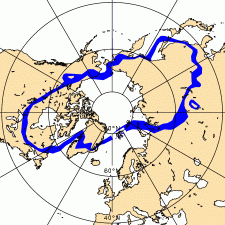Meteorological Physical Background
An Arctic Cold Front is a boundary between arctic and polar air masses. An Arctic air mass forms, when the air above a snow/ice covered surface cools down due to very low solar heating and strong heat emission from the surface. Consequently, it is only found above the polar ice areas. The Arctic Cold Fronts come to Northern Europe only during the winter season, from October to March.
It can be stated that the air mass is arctic, when the 850 hPa temperature is -18°C or lower. The corresponding threshold value for Θe at 850 hPa depends slightly on the humidity of the air mass, but is usually around -4°C. The temperature at 500 hPa is -40°C or lower.
Using this threshold, the image below shows the mean position of the arctic air mass in January.
|
The mean location of Arctic air mass in January (1971-2000); blue: temperature range 254K to 256K
|
We can clearly see that the effect of warm sea currents (particularly the Gulf Stream) pushes the arctic air on an average near to the 75th northern latitude, whereas over the cold continental area in North America and Siberia the Arctic air mass extends even to 50thnorthern latitude.
As stated in Common Remarks, the Arctic Cold Fronts are classified into two categories:
- Baroclinic front
- A Wave with a Warm and a Cold Front forms in a thermal gradient zone accompanied by a weak arctic jet found at 700-500 hPa. It can develop into an Occlusion, or disappear.
- The systems come to Northern Europe within a cold flow, therefore, the Warm Front is very weak and disappears quickly.
- A Back Bent Occlusion often forms in mature systems.
- Most arctic fronts are of this type.
- The difference between Polar and Arctic Cold Fronts:
- Arctic frontal zones are restricted to the lower troposphere
- In arctic situations the tropopause is higher than the top of the front, and often difficult to detect
- There is no jet at 300 hPa over Arctic Fronts
- With Arctic Fronts the only precipitation is in the form of snow
- Arctic systems occlude faster
- Ice/sea boundary front
- The front is formed over the boundary between the relatively warm sea and cold ice and is advected south with the basic flow.
- There is only a Cold Front present.
- Small scale convective cells form immediately behind the front.
